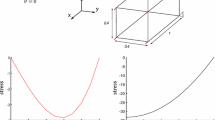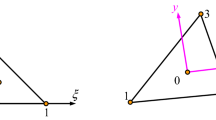Abstract
An 8-node brick element using Allman's displacement interpolation is proposed. The optimal number of 36 stress modes is identified. The six equal-rotation strainless modes which are intrinsic to Allman's interpolation are stabilized by using a penalty method. The penalty also enforces the equality of the nodal rotation and the continuum-defined rotation. To enhance computational efficiency, 39 stress modes are initially assumed, three constraints on the stress field are then imposed. The flexibility matrix is simplified, such that only four symmetric 3 × 3 matrices are required to be inverted. Numerical test results are presented, showing good accuracy.
Similar content being viewed by others
References
Atluri, S. N. (1979): On rate principles for finite strain analysis of elastic and nonelastic solids. Recent Research of Mechanical Behaviour of Solids, 79–107 (Professor H. Miyamoto's Anniversary Volume), University of Tokyo Press
Atluri, S. N. (1980): On some new general and complementary energy principles for the rate problems of finite strain, classic plasticity. J. Struct. Mech. 8, 61–92
Allman, D. J. (1984): A compatible triangular element including vertex rotations for plane elasticity analysis, Comp. and Struct. 19, 1–8
Bergan, P. G.; Felippa, C. A. (1985): A triangular membrane element with rotational degrees of freedom. Comp. Meth. Appl. Mech. Engng. 50, 25–69
Cook, R. D. (1986): On the Allman triangle and a related quadrilateral element. Comp. and Struct. 22, 1065–1067
Cook, R. D.; Malkus, D. S.; Plesha, M. E. (1989): Concepts and applications of finite element analysis, 3rd edn. John Wiley & Sons
Hughes, T. J. R.; Brezzi, F. (1989): On drilling degrees of freedom. Comp. Meth. Appl. Mech. Engng. 72, 105–121
Ibrahimbegovic, A.; Wilson, E. L. (1991): Thick shell and solid finite elements with independent rotation fields. Int. J. Num. Meth. Engng. 31, 1393–1414
Irons, B. M. (1971): Quadrature rules for brick based finite elements. Int. J. Num. Meth. Engng. 3, 293–294 (1971)
Irons, B. M.; Ahmad, S. (1980): Techniques of finite elements, Ellis Horwood
Iura, M.; Atluri, S. N. (1992): Formulation of a membrane finite element with drilling degrees of freedom. Comput. Mech. 9, 412–428
MacNeal, R. H.; Harder, R. L. (1985): A proposed standard set of problems to test finite element accuracy. Finite Elements in Analysis and Design 1, 3–20
MacNeal, R. H.; Harder, R. L. (1989): A refined four-noded membrane element with rotational degrees of freedom. Comp. and Struct. 28, 75–84
Pawlak, T. P.; Yunus, S. M.; Cook, R. D. (1991): Solid elements with rotational degrees of freedom: part II—tetrahedron elements. Int. J. Num. Meth. Engng. 31, 539–610
Pian, T. H. H.; Tong, P. (1969): Basis of finite element methods for solid continua. Int. J. Num. Meth. Engng. 1, 3–28
Pian, T. H. H.; Chen, D.-P.; Kang, D. (1983): A new formulation of hybrid/mixed finite element methods. Comp. and Struct. 16, 81–87
Pian, T. H. H.; Chen, D.-P. (1983): On the suppression of zero energy deformation modes. Int. J. Num. Meth. Engng. 19, 1741–1752
Pian, T. H. H.; Sumihara, K. (1984): Rational approach for assumed stress finite elements. Int. J. Num. Meth. Engng. 20, 1685–1695
Punch, E. F.; Atluri, S. N. (1984): Applications of isoparametric three-dimensional hybrid-stress finite elements with least-order stress fields. Comp. and Struct. 19, 409–430
Reissner, E. (1986): Some aspects of the variational principles problem in elasticity. Comput. Mech. 1, 3–9
Rubinstein, R.; Punch, E. F.; Atluri, S. N. (1983): An analysis of, and remedies for, kinematic modes in hybrid-stress finite elements: selection of stable invariant stress fields. Comp. Meth. Appl. Mech. Engng. 38, 63–92
Sze, K. Y.; Chow, C. L. (1991a): An incompatible element for axisymmetric structure and its modification by hybrid method. Int. J. Num. Meth. Engng. 31, 385–405
Sze, K. Y.; Chow, C. L. (1991b): An efficient hybrid quadrilateral Kirchhoff plate bending element. Int. J. Num. Meth. Engng. 32, 149–169
Sze, K. Y. (1992): Efficient formulation of robust hybrid elements using orthogonal stress/strain interpolants and admissible matrix formulation. Int. J. Num. Meth. Engng. 35, 1–20
Sze, K. Y.; Chow, C. L.; Chen, W.-J. (1992): On invariance of isoparametric hybrid elements. Commun. Appl. Num. Meth. 8, 385–406
Sze, K. Y.; Chen, W.-J.; Cheung, Y. K. (1992): An efficient quadrilateral plane element with drilling degrees of freedom using orthogonal stress modes. Comp. and Struct. 42, 695–705
Sze, K. Y.; Ghali, A. (1992): Hybrid plane quadrilateral element with corner rotations. ASCE—J. Struct. Engng., accepted for publication.
Taylor, R. L.; Simo, J. C.; Zienkiewicz, O. C.; Chan, C. H. (1986): The patch test—a condition for assessing fem convergence. Int. J. Num. Meth. Engng. 22, 39–62
Timoshenko, S. P.; Woinowsky-Krieger, S. (1970): Theory of plates and shells, 2nd edn. McGraw-Hill
Yunus, S. M.; Saigal, S., Cook, R. D. (1989). On improved hybrid finite elements with rotational degrees of freedom. Int. J. Num. Meth. Engng. 28, 785–800
Yunus, S. M.; Pawlak, T. P.; Cook, R. D. (1991): Solid elements with rotational degrees of freedom: part 1—hexahedron elements. Int. J. Num. Meth. Engng. 31, 573–592
Author information
Authors and Affiliations
Additional information
Communicated by S. N. Atluri, September 12, 1992
Rights and permissions
About this article
Cite this article
Sze, K.Y., Ghali, A. A hybrid brick element with rotational degrees of freedom. Computational Mechanics 12, 147–163 (1993). https://doi.org/10.1007/BF00371990
Issue Date:
DOI: https://doi.org/10.1007/BF00371990




